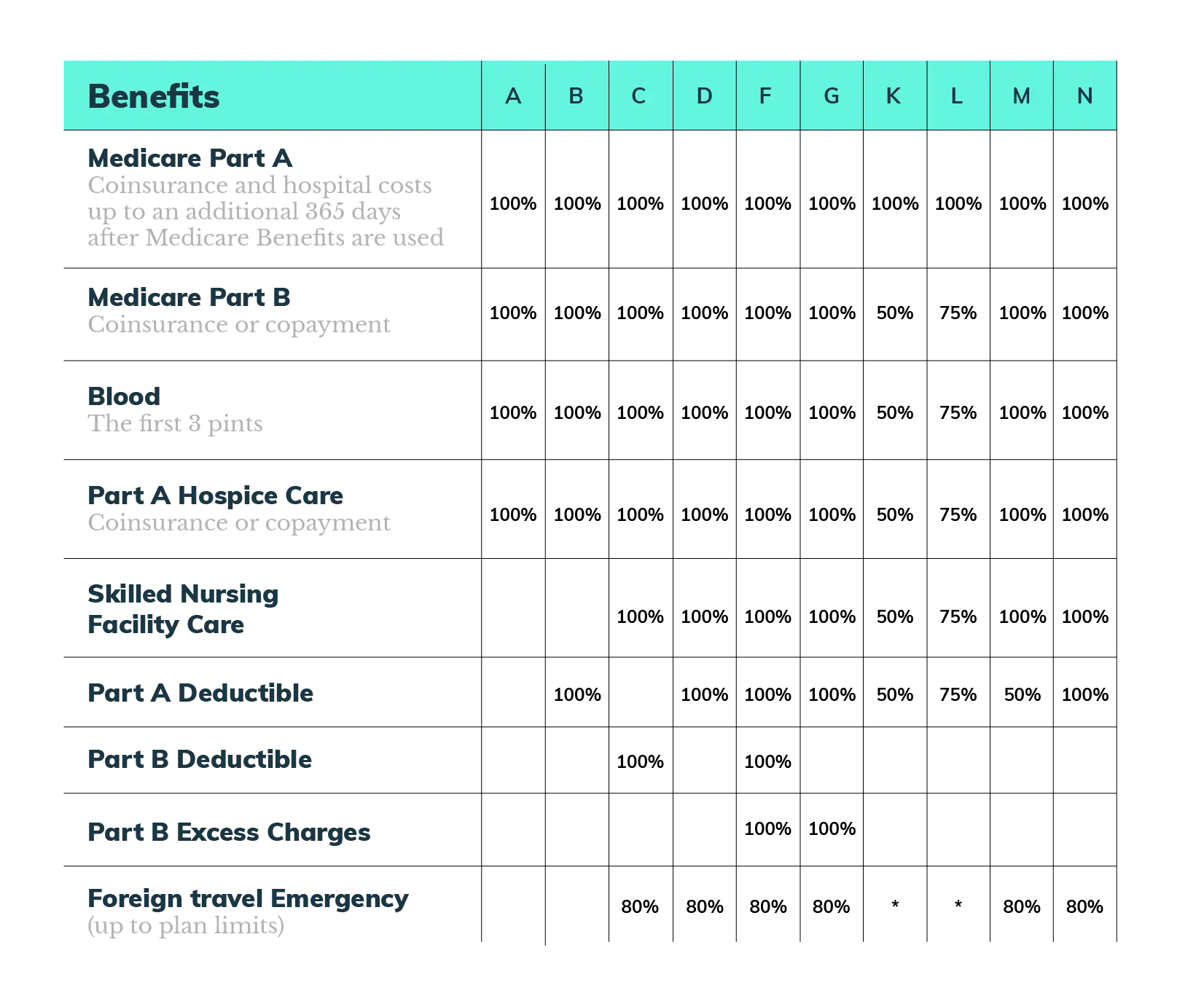The Ultimate Guide to Medicare Supplement Plans in Florida
Read on to learn more about how seniors in Florida manage their out-of-pocket Medicare expenses.
Our content follows strict guidelines for editorial accuracy and integrity. Learn about our and how we make money.
The federal Medicare program is a great option for over-65s, people with ESRD, and disabled individuals who need affordable health coverage.
However, Medicare costs can start to add up, especially if you’re hospitalized for a long time or require frequent visits to your doctor.
Thankfully, private health plans, like Medicare Advantage and Medicare Supplement Insurance can help pay for some of these expenses.
This article will cover Medicare Supplement Plans in Florida, which ones are popular, when the best time is to apply, and how much it will cost each month.
Let’s Recap: What Are Medicare Supplement Plans?
A Medicare Supplement Plan (also known as a Medigap plan) is a health insurance policy that pays for expenses that Medicare does not cover.
These plans help pay for out-of-pocket costs such as deductibles, copayments, and coinsurance.
They also cover expenses such as foreign travel emergencies, blood transfusions, hospice care and excess charges.
Terms you need to know:
Deductible: This refers to the set amount you pay for health care services before your insurance begins to pay. For example, if you have a $1,200 deductible you must pay $1,200 before your insurance kicks in.
Coinsurance is the percentage of costs you pay after your deductible has been met.
Copayments are set rates you must pay for doctor visits, hospital stays and prescriptions.
Out-of-pocket expenses refer to costs that are not covered by Medicare that you must pay for yourself. For example, a fee for a visit to the dentist.
There are ten standardized Supplement Plans that private insurance companies in Florida can sell. Each plan can be identified by a letter: A, B, C, D, F, G, K, L, M and N.
Your level of coverage will depend on which Medicare Supplement Insurance Plan you choose. This could include:
Part of the expense that Original Medicare doesn’t cover, known as the deductible.
20% of the amount you’re responsible for paying. This is called coinsurance.
Any other additional medical costs.
It’s important to note that if you have Medicaid or a Medicare Advantage Plan, it is illegal for an insurance company to sell you a Medicare Supplement Insurance Plan.
If you would like to take a more detailed look at Medicare Supplement Plans and what they offer, be sure to read this article.
Key Takeaways:
In Florida, Medicare Supplement Insurance Plans help cover the expenses that Original Medicare Part A and B don’t cover.
There are ten different Medicare Supplement Plans you can choose from in Florida. They can be identified by a letter: A, B, C, D, F, G, K, L, M and N.
People with Medicaid or Medicare Advantage Plans, can’t buy a Medicare Supplement Plan.

(Source: Unsplash)
When Is the Best Time to Enroll in a Medicare Supplement Plan in Florida?
You can join a Medicare Supplement Plan at any time of the year in Florida. However, the best time to enroll is during your Open Enrollment Period.
You’ll likely have more plans to choose from, find lower Medicare premiums, and your medical history won't be checked by health insurance companies (this process is called medical underwriting).
A Closer Look at Medical Underwriting
Medical Underwriting is a risk assessment done by health insurance companies. During this process, your medical history will be reviewed.
Health insurance companies use medical underwriting to decide:
Whether they will accept people for certain plans.
How much they will have to pay to join.
How long people will have to wait before their medical expenses are covered.
Medical underwriting is not allowed during your Open Enrollment Period to give every newly eligible Medicare beneficiary a fair chance of getting Medicare supplement coverage.
When Does the Open Enrollment Period (OEP) Begin?
Your Open Enrollment Period begins on the first day of the month that your Medicare Part B (Medical Insurance) starts and lasts for six months.
For example, if you sign up for Medicare and your Part B cover starts on April 1st, your Open Enrollment Period will last until September 30th.
For most people, this window only happens once in their life when they turn 65 (unless you collect Social Security Disability Income).
Many people often get confused between their Open Enrollment Period and their Initial Enrollment Period. Here’s a table to show you how they are different:
Open Enrollment Period vs Initial Enrollment Period
| Initial Enrollment Period | Open Enrollment Period | |
|---|---|---|
| What is it for? | If you want to join the Medicare program. | If you want to join a Medicare Supplement Plan. |
| When does it start? | Three months before your 65th birthday month. | The first day of the month that your Part B cover begins. |
| How long does it last? | 7 months | 6 months |
The OEP is one of many Medicare enrollment periods that seniors should know about. We’ve put together this table to outline the differences between each one:
| Enrollment Period | Description |
|---|---|
| Open Enrollment Period | This six-month period begins on the first day of the month when you are 65 or older and enrolled in Medicare Part B. This date will be different for everyone and depends on the month that you sign up. |
| Fall Medicare Open Enrollment Period | During this window, you can change your Medicare Supplemental Insurance Plan without losing any medical coverage. This window takes place every year from October 15th to December 7th. |
| Initial Enrollment Period (IEP) | This is your first chance to sign up for Medicare once you are eligible and begins three months before your 65th birthday. During the IEP, you can sign up for Medicare Parts A and B, a Medicare Advantage Plan or a Part D Prescription Drug Plan. |
| General Enrollment Period | From January 1st to March 31st, you can sign up for Medicare Parts A and B, as well as Medicare Advantage Plans if you missed the deadline. |
| Special Enrollment Period | This period refers to specific situations where you can enroll outside the regular enrollment periods (for example, if you move states or your health care coverage under an employer ends). The dates for the Special Enrollment Period differ from person to person. |
For more information, read our guide to Medicare Open Enrollment Period 2022.
What Are the Most Popular Medicare Supplement Plans?
As we mentioned before, there are ten different Medicare Supplement Insurance Plans that you can choose from. They can be identified by a letter: A, B, C, D, F, G, K, L, M and N.
The table below summarizes the basic Medicare benefits that each plan covers.
Where you see a percentage, the Medicare Supplement Plan covers that percentage of the benefit and you must pay the rest.

Some of these Medicare plans have important details you should be aware of.
For example:
Plans F and G have a high-deductible option in some states. This means that if you choose one of these plans, you must pay a deductible fee of $2,370 before your insurance pays anything.
Plans K and L have out-of-pocket limits of $6,220 and $3,110. Once you have paid these amounts and the Part B deductible of $233, the plan will pay 100% of your covered services for the rest of the year.
Plans C and F are only available to people who qualified for Medicare before 1 January 2020.
Plan N will pay 100% of the Part B coinsurance. You will have to pay up to $20 for doctor visits and $50 to go to the emergency room (as long as you are not admitted to the hospital).
Let’s Take a Look at the Most Popular Plans in Florida
According to research, in Florida, Medicare Supplement Plans F, J and N were the most popular in 2019.
Medicare Supplement Plan Enrollment Numbers (2019)
Plan F: 577,741
Plan N: 81,929
Plan J: 60,533
Medicare Supplement Plan F
This is a popular choice for seniors because it covers almost all of the Medicare benefits that Medicare Part A and B don’t pay for.
There is a standard and high-deductible version of Plan F. As of 2021, the high-deductible amount was $2,370.
This means that you would have to reach or pay the amount of $2,370 before the plan begins to cover your medical expenses.
Due to the fact that Plan F offers such comprehensive coverage, the premiums are generally more expensive than the other Supplement Plans.
If you’d like to find out more about the eligibility requirements of Medicare Supplement Plan F and how much it could cost you, read this article.
Medicare Supplement Plan N
Plan N also covers the majority of Medicare expenses, with the exception of the Part B deductible and excess charges.
This means that you must pay the $233 annual Part B deductible fee before Medicare starts to pay and you can use your Plan N benefits.
Excess charges are fees for services, tests, and items that are higher than the Medicare-approved levels.
For example, if a medical expense costs $500 more than the Medicare-approved amount, your Medicare Plan N will not reimburse the difference. You must pay 20% of the total amount (Medicare will pay 80%) and you must cover the extra $500.
Our article on Medicare Plan N outlines what you need to know about this Supplement Plan. This includes what it covers, how to enroll, and what you can expect to pay.
If you are still unsure or have any questions about Florida Medicare Supplement Plans, contact one of PolicyScout’s friendly Medicare consultants.
Medicare Supplement Plan JPlan J covers Part A and B deductibles, coinsurance, and copayments. It also covers part B excess charges, hospice care, foreign travel emergencies, blood, and care in a skilled nursing facility.
Plan J is popular in Florida because there is a larger population of older Medicare beneficiaries. Unfortunately, since 2010 health insurance companies haven’t been allowed to sell Plan J.
Plan J was discontinued because it offers similar benefits to Medicare Part D, which was added in 2003.
However, if you purchased Plan J before June 2010 you can keep your plan. You can also change your Medicare Supplement provider and still keep Plan J.
Similarly, if you purchased Plan J before 2006 when it offered prescription drug coverage, you can also keep it.
For more information on what Medicare Plan J covers and what you can expect to pay in monthly premiums, read our guide to Medicare Supplement Plans.
Remember:
Medicare Part B covers outpatient services like specialist consultations, vaccines, screenings and walkers.
A deductible is a set amount you must pay for health care before your insurance begins to pay.
How Much Do Medicare Supplement Plans Cost in Florida?
Although the benefits of Medicare Supplement Plans are standardized, monthly premiums might vary, and health insurance firms can set their own pricing for coverage.
Remember that your location, health, and lifestyle will be considered when a health insurance company sets your rate.
A health insurance firm, for example, may:
Want to primarily offer Medicare Supplement Insurance to non-smokers.
Only offer Medicare Supplement plans in a few counties.
Charge higher fees to ensure all their members have proper coverage.
In general, there are three ways that a health insurance provider can set their premiums.
These are:
Community-rated: This premium is not based on your age. This means that the same monthly premium is charged to everyone. However, the price will vary according to inflation.
Issue-age rated: This premium will be based on the age you are when you buy the policy. Therefore, the premium is lower for people who buy it at a younger age and won’t change as you get older.
Attained-age rated: This premium is based on your current age and will go up as you get older. Although these premiums might be the least expensive at first, they will eventually become the most expensive and are also affected by inflation.
It’s important to note that your location and lifestyle habits will also be considered when a health insurance company sets your premium.
Let’s look at an example to give you an idea of how much Medicare Supplement Plans could cost you in Florida.
Meet John
John is a 65-year old man living in Tampa, Florida. His postcode is 33601, and he is a non-tobacco user. He is trying to decide between Medicare Supplement Plans B, D and N.
Pricing Disclaimer:
Note that all prices and costs in this article are estimates and should not be viewed as the amount you will pay for Medicare Supplement Insurance.
All displayed prices and charges are subject to change. If you want to know how much supplemental insurance might cost you, contact PolicyScout to get an accurate estimate.

(Source: Unsplash)
Plan B
The premiums range from $102 to $311. This does not include the $170.10 standard monthly premium for the Part B deductible.
Example - John’s monthly expenses for Plan B
Part B monthly premium: $170.10
Medicare Plan B monthly premium: $102 - $311
Total monthly costs: $272.10 - $481.10
If he chooses this plan, he will not have any copayments or coinsurance. However, he will have to meet the $233 Medicare Part B deductible.
A Recap of Key Terms:
Deductible: This refers to the set amount you pay for health care services before your insurance begins to pay.
Coinsurance: The percentage of costs you pay after your deductible has been met.
Copayment: A set rate you must pay for doctor visits, hospital stays and prescriptions.
This plan does not cover the Part B excess charges. This means that John could pay up to 15% more if he visits a doctor who does not accept Medicare.
If John ever needed care in a skilled nursing facility, Plan B would not cover these expenses.
Plan B Benefits:
❌ Skilled Nursing Facility
✅ Part A Deductible
❌ Part B Deductible
❌ Part B Excess Charges
❌ Foreign Travel Emergency
Plan D
For Medicare Plan D, the monthly premiums range from $108 to $241. This also does not include the $170.10 standard Part B premium.
Example - John’s monthly expenses for Plan D
Part B monthly premium: $170.10
Medicare Plan D monthly premium: $108 - $311
Total monthly costs: $278.10 - $481.10
Similar to Plan B he will not have any copayments or coinsurance, but he will have to meet the $233.00 Medicare Part B deductible.
He will also have to cover the Part B excess charges if he visits a doctor who does not accept Medicare.
He will have foreign emergency travel benefits with Plan D to a maximum lifetime benefit of $50,000. However, he will first have to pay a $250 deductible for these benefits to kick in.
Plan D Benefits:
✅ Skilled Nursing Facility
✅ Part A Deductible
❌ Part B Deductible
❌ Part B Excess Charges
✅ Foreign Travel Emergency
Plan N
If John chooses Medicare Supplement Plan N, he can expect a monthly premium of between $70 and $400. Like the plans above, this does not include the $170.10 standard Part B premium.
Example - John’s monthly expenses for Plan N
Part B Monthly Premium: $170.10
Medicare Plan N Monthly Premium: $70 - $400
Total Monthly costs: $240.10 - $570.10
When John visits the doctor or the emergency room, he will have to cover copayments of $20 and $50.
John will also have to meet the $233 Medicare Part B deductible and can expect to pay excess charges for visits to doctors who don’t accept Medicare.
Similar to Plan D, Medicare Plan N also includes foreign travel emergency benefits.
Plan N Benefits:
✅ Skilled Nursing Facility
✅ Part A Deductible
❌ Part B Deductible
❌ Part B Excess Charges
✅ Foreign Travel Emergency
The table below summarizes the costs and benefits of each of the Medicare Supplement Plans John is interested in:
| Plan B | Plan D | Plan N | |
|---|---|---|---|
| Monthly premiums | $102 to $311 | $108 to $241 | $70 to $400 |
| Medicare Part B premium cover | No | No | No |
| Copayments | None for approved Part B (outpatient) services. | None for approved Part B (outpatient) services. | $20 for visits to the doctor.$50 for visits to the hospital. |
| Deductible costs | $233 (Part B) | $233 (Part B) | $233 (Part B) |
| Foreign Travel Emergency Cover | Yes | Yes | Yes |
| Part B Excess Charges | Not covered | Not covered | Not covered |
As you can see, in Florida, Medicare Supplement Plans, their coverage, and their premiums are different.
You should always compare Medicare Supplement Plans before purchasing a plan, as this will allow you to choose the one that is best for your health care needs and budget.
If you’d like to find out how much you could expect to pay for Medicare Supplement Insurance, visit the official website of the federal government Medicare program.
Where Can I Find Out More about Medicare and Supplement Insurance?
If you’re wondering about Medicare and your coverage options, be sure to check out our Medicare Hub which is filled with the latest information about costs, Medicare benefits, and insurance options.
If you’d rather speak with someone, reach out to one of our trained Medicare consultants to get up-to-date answers to your questions about Medicare Advantage plans, Medicare coverage, and out-of-pocket expenses.
You can contact us by phone at 1-888-912-2132 or email us at Help@PolicyScout.com.